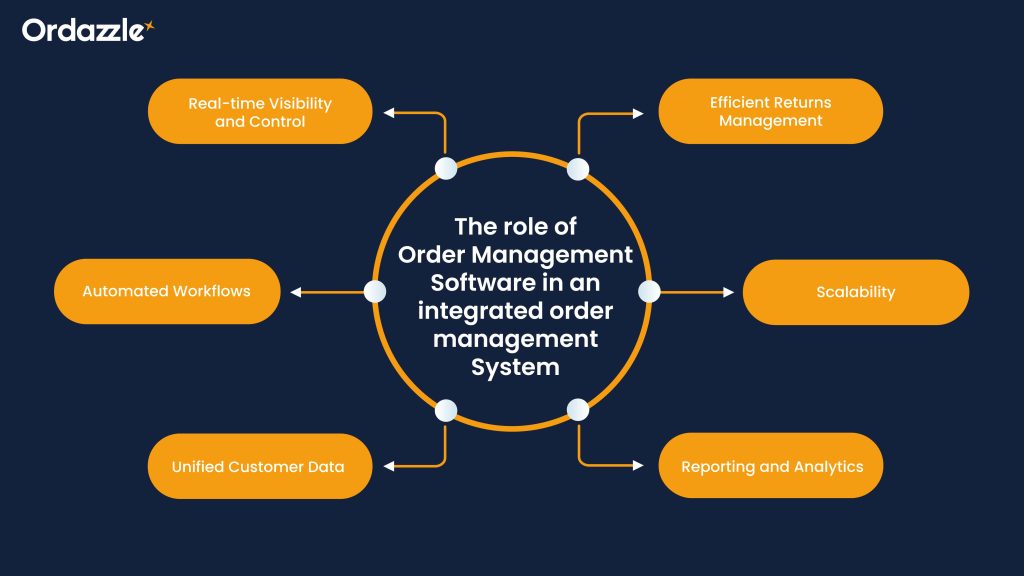
Enhancing Operational Efficiency with Integrated Order Management
Behind every e-commerce business is a complex web of operations. Businesses tirelessly work to streamline processes, cut costs, and offer a seamless shopping experience. The heartbeat of these efforts? A strong focus on operational efficiency.
So, what stands at the core of this efficiency? It’s how businesses handle their orders. This is where order management and its supportive software come into play.
In this blog, we’ll discuss everything related to achieving operational excellence through an integrated order management strategy.
Why Operational Efficiency Matters?
The e-commerce space is bursting with competitors. Businesses need more than just ambition to stand out: they need tools that supercharge their operations.
Why does operational excellence hold such gravitas? It’s the catalyst that drives cost efficiency, customer satisfaction, competitive advantage, risk mitigation, scalability, and organizational alignment. Striving for such excellence allows organizations to optimize their performance, maximize productivity, enhance their market position, and achieve sustainable success.
Central to this excellence is managing customer orders effectively. From the initial click to the final drop-off, a strong integrated e-commerce order management system is crucial.
The significance of effective order management for Operational excellence
Previously, businesses managed their e-commerce processes manually or through isolated systems. Today, with online orders reaching unprecedented numbers and customers demanding seamless experiences, relying on outdated methods won’t cut it anymore.
What businesses need now is an integrated order management system. This tool tracks every step, from order placement to delivery, ensuring inventory accuracy, proper product dispatch, prompt shipping, and quality after-sales service.
At the core of such a system is the robust order management software. A powerful order management software, the driving force ensuring optimal efficiency and precision.
The role of Order Management Software in an integrated order management System

Here’s how it enhances operational efficiency:
Real-time Visibility and Control:
With integrated systems, businesses can instantly view inventory, ongoing orders, and shipments. This immediate insight ensures timely decision-making and better inventory management.
Automated Workflows:
Automation minimizes errors and manual tasks. It speeds up order processing and guarantees satisfied customers through prompt deliveries.
Unified Customer Data:
Integrating order management with other e-commerce management tools offers a complete customer view, aiding in personalized shopping experiences and better marketing strategies.
Efficient Returns Management:
Managing returns can be a hassle for e-commerce businesses. An integrated system simplifies returns, making them quicker and more cost-effective.
Scalability:
As businesses grow, so do the complexity and volume of orders. Integrated software ensures scalability, handling more orders without compromising efficiency.
Reporting and Analytics:
Advanced reporting and analytics tools reveal essential data like order volume, customer trends, and more. These insights help identify bottlenecks, areas for improvement, and trends, enabling organizations to optimize their order management processes and drive operational efficiency.
Strategy to Achieve Operational Efficiency Through Integrated Order Management
Achieving top-tier efficiency is an ongoing mission. Here are the Integrated Order Management strategies for businesses eager to master integrated order management:
Define Clear Objectives:
Start by outlining the goals and results that operational excellence will help you attain. These goals have to align with your total organization strategy and should center on issues like effectiveness, caliber, client happiness, cost-cutting, and innovation.
Develop a Comprehensive Strategy:
Make a thorough plan outlining your approach to achieving operational efficiency. This approach should include specific projects, action plans, and performance indicators that will spur change in many areas of your business.
Centralize Operations:
Operations complexity is decreased by using a single platform to manage everything from inventory to shipping. Centralization sped up processes, which guarantees consistent data and eliminates duplication.
Leverage Data Analytics:
The data in integrated systems is plentiful. Businesses may use these data for trend analysis, predictive analytics, and actionable insights directly affecting their bottom line.
Prioritize Customer Experience:
Ultimately, every operational choice should improve the customer experience. With an efficient e-commerce order management system, businesses can offer quicker deliveries, real-time order tracking, simple returns, and more.
Continuous Learning and Adaptation:
The e-commerce landscape is ever-evolving. Integrated systems provide tools for monitoring performance metrics and KPIs. Regular reviews and adaptability can help businesses stay ahead of the curve.
Conclusion
For e-commerce businesses to thrive in a competitive landscape, integrating order management supported by the right order management software and harnessing its potential is the key. Bringing all operations under one roof, making the most out of data, and always seeking ways to do better, businesses don’t just streamline tasks; they set themselves on a path of steady growth in an ever-competitive market.
But as orders start pouring in, managing every detail manually can get challenging. That’s where Ordazzle comes in. With our integrated order management system, you can focus more on expanding your business and less on the nitty-gritty of order management.
Ready to elevate your e-commerce game? Connect with us today to embark on a journey towards unparalleled operational brilliance.
Why Operational Efficiency Matters?
The e-commerce space is bursting with competitors. Businesses need more than just ambition to stand out: they need tools that supercharge their operations.
Why does operational excellence hold such gravitas? It’s the catalyst that drives cost efficiency, customer satisfaction, competitive advantage, risk mitigation, scalability, and organizational alignment. Striving for such excellence allows organizations to optimize their performance, maximize productivity, enhance their market position, and achieve sustainable success.
Central to this excellence is managing customer orders effectively. From the initial click to the final drop-off, a strong integrated e-commerce order management system is crucial.
The significance of effective order management for Operational excellence
Previously, businesses managed their e-commerce processes manually or through isolated systems. Today, with online orders reaching unprecedented numbers and customers demanding seamless experiences, relying on outdated methods won’t cut it anymore.
What businesses need now is an integrated order management system. This tool tracks every step, from order placement to delivery, ensuring inventory accuracy, proper product dispatch, prompt shipping, and quality after-sales service.
At the core of such a system is the robust order management software. A powerful order management software, the driving force ensuring optimal efficiency and precision.
The role of Order Management Software in an integrated order management System

Here’s how it enhances operational efficiency:
Real-time Visibility and Control:
With integrated systems, businesses can instantly view inventory, ongoing orders, and shipments. This immediate insight ensures timely decision-making and better inventory management.
Automated Workflows:
Automation minimizes errors and manual tasks. It speeds up order processing and guarantees satisfied customers through prompt deliveries.
Unified Customer Data:
Integrating order management with other e-commerce management tools offers a complete customer view, aiding in personalized shopping experiences and better marketing strategies.
Efficient Returns Management:
Managing returns can be a hassle for e-commerce businesses. An integrated system simplifies returns, making them quicker and more cost-effective.
Scalability:
As businesses grow, so do the complexity and volume of orders. Integrated software ensures scalability, handling more orders without compromising efficiency.
Reporting and Analytics:
Advanced reporting and analytics tools reveal essential data like order volume, customer trends, and more. These insights help identify bottlenecks, areas for improvement, and trends, enabling organizations to optimize their order management processes and drive operational efficiency.
Strategy to Achieve Operational Efficiency Through Integrated Order Management
Achieving top-tier efficiency is an ongoing mission. Here are the Integrated Order Management strategies for businesses eager to master integrated order management:
Define Clear Objectives:
Start by outlining the goals and results that operational excellence will help you attain. These goals have to align with your total organization strategy and should center on issues like effectiveness, caliber, client happiness, cost-cutting, and innovation.
Develop a Comprehensive Strategy:
Make a thorough plan outlining your approach to achieving operational efficiency. This approach should include specific projects, action plans, and performance indicators that will spur change in many areas of your business.
Centralize Operations:
Operations complexity is decreased by using a single platform to manage everything from inventory to shipping. Centralization sped up processes, which guarantees consistent data and eliminates duplication.
Leverage Data Analytics:
The data in integrated systems is plentiful. Businesses may use these data for trend analysis, predictive analytics, and actionable insights directly affecting their bottom line.
Prioritize Customer Experience:
Ultimately, every operational choice should improve the customer experience. With an efficient e-commerce order management system, businesses can offer quicker deliveries, real-time order tracking, simple returns, and more.
Continuous Learning and Adaptation:
The e-commerce landscape is ever-evolving. Integrated systems provide tools for monitoring performance metrics and KPIs. Regular reviews and adaptability can help businesses stay ahead of the curve.
Conclusion
For e-commerce businesses to thrive in a competitive landscape, integrating order management supported by the right order management software and harnessing its potential is the key. Bringing all operations under one roof, making the most out of data, and always seeking ways to do better, businesses don’t just streamline tasks; they set themselves on a path of steady growth in an ever-competitive market.
But as orders start pouring in, managing every detail manually can get challenging. That’s where Ordazzle comes in. With our integrated order management system, you can focus more on expanding your business and less on the nitty-gritty of order management.
Ready to elevate your e-commerce game? Connect with us today to embark on a journey towards unparalleled operational brilliance.



